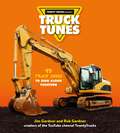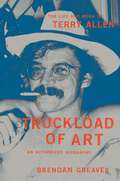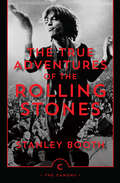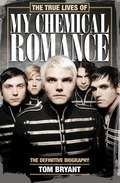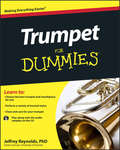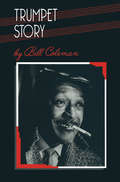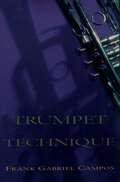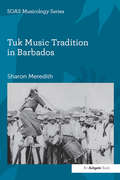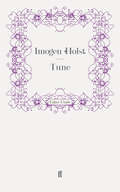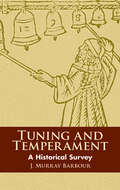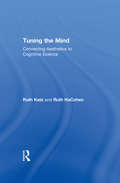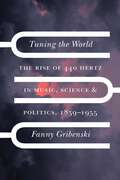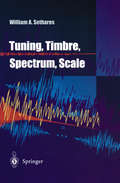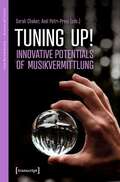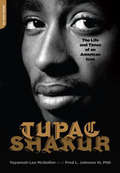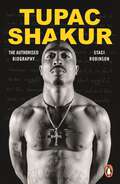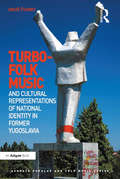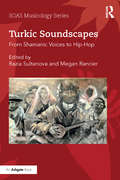- Table View
- List View
Truck Tunes: 45 Truck Songs to Sing Aloud Together
by Jim Gardner Rob GardnerFrom the creators of the popular Truck Tunes and Twenty Trucks songs comes a bright, fun singalong book celebrating kids' favorite trucks! Sing and dance your way into the world of trucks with this collection of 45 catchy, fun, and educational truck songs accompanied by photographs of real trucks in action. From the creators of Twenty Trucks and Truck Tunes comes the first-ever book with this brand. From timeless classics such as dump trucks, fire trucks, excavators, and cement mixers to the not-so-known but equally amazing concrete boom pumps, delimbers, vacuum trucks, and more, this is the must-have book for the truck-loving toddler and young child in any family.
Truckload of Art: The Life and Work of Terry Allen—An Authorized Biography
by Brendan GreavesThe definitive, authorized, and first-ever biography of Terry Allen, the internationally acclaimed visual artist and iconoclastic songwriter who occupies an utterly unique position straddling the disparate, and usually distant, worlds of conceptual art and country music. &“People tell me it&’s country music,&” Terry Allen has joked, &“and I ask, &‘Which country?&’&” For nearly sixty years, Allen&’s inimitable art has explored the borderlands of memory, crossing boundaries between disciplines and audiences by conjuring indelible stories out of the howling West Texas wind. In Truckload of Art, author Brendan Greaves exhaustively traces the influences that shaped Allen&’s extraordinary life, from his childhood in Lubbock, Texas, spent ringside and sidestage at the wrestling matches and concerts his father promoted, to his formative art-school years in incendiary 1960s Los Angeles, and through subsequent decades doggedly pursuing his uncompromising artistic vision. With humor and critical acumen, Greaves deftly recounts how Allen built a career and cult following with pioneering independent records like Lubbock (on everything) (1979)—widely considered an archetype of alternative country—and multiyear, multimedia bodies of richly narrative, interconnected art and theatrical works, including JUAREZ (ongoing since 1968), hailed as among the most significant statements in the history of American vernacular music and conceptual art. Drawing on hundreds of revealing interviews with Allen himself, his family members, and his many notable friends, colleagues, and collaborators—from musicians like David Byrne and Kurt Vile to artists such as Bruce Nauman and Kiki Smith—and informed by unprecedented access to the artist&’s home, studio, journals, and archives, Greaves offers a poetic, deeply personal portrait of arguably the most singularly multivalent storyteller of the American West.
The True Adventures of the Rolling Stones (Canons #16)
by Stanley Booth'Stanley Booth's book is the only one I can read and say, "Yeah, That's how it was"' KEITH RICHARDS 'An epic, behind-the-scenes record of life with the greatest rock band in the world' Observer The True Adventures of the Rolling Stones is the greatest book about the greatest rock 'n' roll band in history. It is also one of the most important books about the 1960s, capturing its uneasy mix of excess, violence and idealism in a way no other book does. Stanley Booth was with the Rolling Stones on their 1969 U.S. tour, which culminated in the notorious free concert at Altamont where a fan was murdered. Taking nearly fifteen years to write, The True Adventures of the Rolling Stones has emerged as 'the one authentic masterpiece of rock 'n' roll writing'.
The True Lives of My Chemical Romance: The Definitive Biography
by Tom BryantMy Chemical Romance are the most significant band in alternative rock for the last decade, selling 5 million albums and selling out arenas worldwide until their split after twelve years together. Author Tom Bryant has been given unparalleled access to the band over the course of their extraordinary career and has a unique archive of interviews with Gerard Way and his brother Mikey, Ray Toro and Frank Iero, as well as their friends and those closest to them, allowing him to go behind the scenes and bring their stories to life. In this unauthorised biography he takes us from their New Jersey beginnings to international superstardom, from the demons they have battled to the power of their lyrics and their extraordinary connection with their fans. This is a definitive account of the most adored rock band this century, a story of self-belief and the pursuit of dreams.
Trumpet For Dummies
by Jeffrey ReynoldsHow to get a good sound, read music, and master a variety of styles-including classical, pop, jazz, and Latin Listening to a trumpet trilla series of high notes during a military march or wail longingly during a blues rendition-is a pleasure second to none. And masters, including Wynton Marsalis and Louis Armstrong, have made the trumpet truly Gabriel's horn, one of the most eloquent voices in classical music and jazz. Yet even a virtuoso begins somewhere. This down-to-earth and user-friendly guide shows those new to the trumpet everything they need know to play the instrument-from basic technique (including getting a good sound), caring for a trumpet, and learning pieces from many musical genres. Demonstrates how to play classical, pop, jazz, and Latin-with audio samples on the enclosed CD-ROM Includes tips on how to buy or rent the best instrument An ideal guide for students just learning the trumpet, or students who need a little boost, or fans of the trumpet who've never got around to learning it, here is the complete guide to making one of the world's most popular-and beloved instruments-their own. Note: CD-ROM/DVD and other supplementary materials are not included as part of eBook file.
Trumpet For Dummies
by Jeffrey ReynoldsHow to get a good sound, read music, and master a variety of styles-including classical, pop, jazz, and Latin Listening to a trumpet trilla series of high notes during a military march or wail longingly during a blues rendition-is a pleasure second to none. And masters, including Wynton Marsalis and Louis Armstrong, have made the trumpet truly Gabriel's horn, one of the most eloquent voices in classical music and jazz. Yet even a virtuoso begins somewhere. This down-to-earth and user-friendly guide shows those new to the trumpet everything they need know to play the instrument-from basic technique (including getting a good sound), caring for a trumpet, and learning pieces from many musical genres. Demonstrates how to play classical, pop, jazz, and Latin-with audio samples on the enclosed CD-ROM Includes tips on how to buy or rent the best instrument An ideal guide for students just learning the trumpet, or students who need a little boost, or fans of the trumpet who've never got around to learning it, here is the complete guide to making one of the world's most popular-and beloved instruments-their own. Note: CD-ROM/DVD and other supplementary materials are not included as part of eBook file.
Trumpet Story
by Bill ColemanBill Coleman was one of the most important jazz trumpeters of the swing era. Born in France in 1909, he moved to New York in 1927. Over the next few years he made his name playing with many of the top bandleaders, including Luis Russell, Benny Carter and Fats Waller. In 1935 he returned to France and performed with Lucky Millinder. He spent the war years in New York, playing with, among others, Andy Kirk, Mary Lou Williams, Sy Oliver and Billy Kyle, before returning to Paris in 1941 to lead his own band. Bill Coleman toured widely and the book contains fascinating anecdotes about his trips to India, Egypt, the Philippines and Japan. He died in 1981 and Trumpet Story was published in French in that year.
Trumpet Technique
by Frank Gabriel CamposIn the last forty years, many elite performers in the arts have gleaned valuable lessons and techniques from research and advances in sport science, psychomotor research, learning theory, and psychology. Numerous "peak performance" books have made these tools and insights available to athletes. Now, professor and performer Frank Gabriel Campos has translated this concept for trumpet players and other brass and wind instrumentalists, creating an accessible and comprehensive guide to performance skill. Trumpet Technique combines the newest research on skill acquisition and peak performance with the time-honored and proven techniques of master teachers and performers. All aspects of brass technique are discussed in detail, including the breath, embouchure, oral cavity, tongue, jaw, and proper body use, as well as information on performance psychology, practice techniques, musicians' occupational injuries, and much more. Comprehensive and detailed, Trumpet Technique is an invaluable resource for performers, teachers, and students at all levels seeking to move to the highest level of skill with their instrument.
Trumpet Technique
by Frank Gabriel CamposIn the last forty years, many elite performers in the arts have gleaned valuable lessons and techniques from research and advances in sport science, psychomotor research, learning theory, and psychology. Numerous "peak performance" books have made these tools and insights available to athletes. Now, professor and performer Frank Gabriel Campos has translated this concept for trumpet players and other brass and wind instrumentalists, creating an accessible and comprehensive guide to performance skill. Trumpet Technique combines the newest research on skill acquisition and peak performance with the time-honored and proven techniques of master teachers and performers. All aspects of brass technique are discussed in detail, including the breath, embouchure, oral cavity, tongue, jaw, and proper body use, as well as information on performance psychology, practice techniques, musicians' occupational injuries, and much more. Comprehensive and detailed, Trumpet Technique is an invaluable resource for performers, teachers, and students at all levels seeking to move to the highest level of skill with their instrument.
Tuk Music Tradition in Barbados (SOAS Studies in Music Series)
by Sharon MeredithBarbados is a small Caribbean island better known as a tourist destination rather than for its culture. The island was first claimed in 1627 for the English King and remained a British colony until independence was gained in 1966. This firmly entrenched British culture in the Barbadian way of life, although most of the population are descended from enslaved Africans taken to Barbados to work on the sugar plantations. After independence, an official desire to promulgate the country’s African heritage led to the revival and recontextualisation of cultural traditions. Barbadian tuk music, a type of fife and drum music, has been transformed in the post-independence period from a working class music associated with plantations and rum shops to a signifier of national culture, played at official functions and showcased to tourists. Based on ethnographic and archival research, Sharon Meredith considers the social, political and cultural developments in Barbados that led to the evolution, development and revival of tuk as well as cultural traditions associated with it. She places tuk in the context of other music in the country, and examines similar musics elsewhere that, whilst sharing some elements with tuk, have their own individual identities.
Tuk Music Tradition in Barbados (SOAS Studies in Music Series)
by Sharon MeredithBarbados is a small Caribbean island better known as a tourist destination rather than for its culture. The island was first claimed in 1627 for the English King and remained a British colony until independence was gained in 1966. This firmly entrenched British culture in the Barbadian way of life, although most of the population are descended from enslaved Africans taken to Barbados to work on the sugar plantations. After independence, an official desire to promulgate the country’s African heritage led to the revival and recontextualisation of cultural traditions. Barbadian tuk music, a type of fife and drum music, has been transformed in the post-independence period from a working class music associated with plantations and rum shops to a signifier of national culture, played at official functions and showcased to tourists. Based on ethnographic and archival research, Sharon Meredith considers the social, political and cultural developments in Barbados that led to the evolution, development and revival of tuk as well as cultural traditions associated with it. She places tuk in the context of other music in the country, and examines similar musics elsewhere that, whilst sharing some elements with tuk, have their own individual identities.
Tune: The Structure Of Melody
by Imogen HolstImogen Holst's Tune (Faber, 1962) is a searching enquiry into the invention of tune and at the same time a comprehensive anthology of tunes from folksong to the present day. Plainsong, street-cries, the songs of the English lutenists, Bach's dances, and Mozart's arias - whatever the origins and character of the tunes in question, Imogen Holst (daughter of the composer, Gustav Holst) has something fresh and revealing to say about them. And she does not confine herself to familiar ground. One of her most illuminating chapters is devoted to the music of India, where a raga can provide improvised 'tune' of several hours duration. This chapter is the result of her personal experience of studying music in India, and it is typical of her vivid approach to the subject. Her book is for everyone who likes to sing, play, whistle, hum or listen to a good tune.
Tuning and Temperament: A Historical Survey
by J. Murray BarbourThe demands of tuning (attaining the perfect scale) and temperament (the compromises necessary for composing in every key) have challenged musicians from the earliest civilizations onward. This guide surveys these longstanding problems, devoting a chapter to each principal theory and offering a running account of the complete history of tuning and temperament. Organized chronologically, the book features a helpful glossary and numerous illustrative tables, and it requires minimal background in music theory. This new reissue is currently the only edition in print of a much-quoted classic. 9 figures. 180 tables.
Tuning the Mind: Connecting Aesthetics to Cognitive Science
by Ruth HaCohenStarting from the late Renaissance, efforts to make vocal music more expressive heightened the power of words, which, in turn, gave birth to the modern semantics of musical expression. As the skepticism of seventeenth-century science divorced the acoustic properties from the metaphysical qualities of music, the door was opened to dicern the rich links between musical perception and varied mental faculties. In Tuning the Mind, Ruth Katz and Ruth HaCohen trace how eighteenth century theoreticians of music examined anew the role of the arts within a general theory of knowledge.As the authors note, the differences between the physical and emotional dimensions of music stimulated novel conceptions and empirical inquiries into the old aesthetic queries. Tracing this development, their opening chapter deals with seventeenth-century epistemological issues concerning the artistic qualities of music. Katz and HaCohen show that painting and literature displayed a comparable tendency toward "musicalization," whereby the dynamic of forms-the modalities specific to each artistic medium-rather than subject matter was believed to determine expression. Katz and HaCohen explore the ambiguities inherent in idealization of an art form whose mimetic function has always been problematic. They discuss the major outlines of this development, from Descartes to Vico through Condillac. Particular emphasis is placed on eighteenth-century British thinkers, from Shaftesbury to Adam Smith, who perceived these problems in their full complexity. They also explore how the French and the Germans dealt differently with questions that preoccupied the British, each nation in accordance with their own past tradition and tendencies. The concluding chapter summarizes the parallel development of abstract art and basic hypotheses concerning the mind and explores basic theoretical questions pertaining to the relationship between perception and cognition.In addressing some of the most complex problems in musical aesthetics, Katz and HaCohen provide a unique historical perspective on the ways their art creates and develops coherent worlds, and, in so doing, contribute to our understanding of the workings of the mind.
Tuning the Mind: Connecting Aesthetics to Cognitive Science
by Ruth HaCohenStarting from the late Renaissance, efforts to make vocal music more expressive heightened the power of words, which, in turn, gave birth to the modern semantics of musical expression. As the skepticism of seventeenth-century science divorced the acoustic properties from the metaphysical qualities of music, the door was opened to dicern the rich links between musical perception and varied mental faculties. In Tuning the Mind, Ruth Katz and Ruth HaCohen trace how eighteenth century theoreticians of music examined anew the role of the arts within a general theory of knowledge.As the authors note, the differences between the physical and emotional dimensions of music stimulated novel conceptions and empirical inquiries into the old aesthetic queries. Tracing this development, their opening chapter deals with seventeenth-century epistemological issues concerning the artistic qualities of music. Katz and HaCohen show that painting and literature displayed a comparable tendency toward "musicalization," whereby the dynamic of forms-the modalities specific to each artistic medium-rather than subject matter was believed to determine expression. Katz and HaCohen explore the ambiguities inherent in idealization of an art form whose mimetic function has always been problematic. They discuss the major outlines of this development, from Descartes to Vico through Condillac. Particular emphasis is placed on eighteenth-century British thinkers, from Shaftesbury to Adam Smith, who perceived these problems in their full complexity. They also explore how the French and the Germans dealt differently with questions that preoccupied the British, each nation in accordance with their own past tradition and tendencies. The concluding chapter summarizes the parallel development of abstract art and basic hypotheses concerning the mind and explores basic theoretical questions pertaining to the relationship between perception and cognition.In addressing some of the most complex problems in musical aesthetics, Katz and HaCohen provide a unique historical perspective on the ways their art creates and develops coherent worlds, and, in so doing, contribute to our understanding of the workings of the mind.
Tuning the World: The Rise of 440 Hertz in Music, Science, and Politics, 1859–1955 (New Material Histories of Music)
by Fanny GribenskiTuning the World tells the unknown story of how the musical pitch A 440 became the global norm. Now commonly accepted as the point of reference for musicians in the Western world, A 440 hertz only became the standard pitch during an international conference held in 1939. The adoption of this norm was the result of decades of negotiations between countries, involving a diverse group of performers, composers, diplomats, physicists, and sound engineers. Although there is widespread awareness of the variability of musical pitches over time, as attested by the use of lower frequencies to perform early music repertoires, no study has fully explained the invention of our current concert pitch. In this book, Fanny Gribenski draws on a rich variety of previously unexplored archival sources and a unique combination of musicological perspectives, transnational history, and science studies to tell the unknown story of how A 440 became the global norm. Tuning the World demonstrates the aesthetic, scientific, industrial, and political contingencies underlying the construction of one of the most “natural” objects of contemporary musical performance and shows how this century-old effort was ultimately determined by the influence of a few powerful nations.
Tuning the World: The Rise of 440 Hertz in Music, Science, and Politics, 1859–1955 (New Material Histories of Music)
by Fanny GribenskiTuning the World tells the unknown story of how the musical pitch A 440 became the global norm. Now commonly accepted as the point of reference for musicians in the Western world, A 440 hertz only became the standard pitch during an international conference held in 1939. The adoption of this norm was the result of decades of negotiations between countries, involving a diverse group of performers, composers, diplomats, physicists, and sound engineers. Although there is widespread awareness of the variability of musical pitches over time, as attested by the use of lower frequencies to perform early music repertoires, no study has fully explained the invention of our current concert pitch. In this book, Fanny Gribenski draws on a rich variety of previously unexplored archival sources and a unique combination of musicological perspectives, transnational history, and science studies to tell the unknown story of how A 440 became the global norm. Tuning the World demonstrates the aesthetic, scientific, industrial, and political contingencies underlying the construction of one of the most “natural” objects of contemporary musical performance and shows how this century-old effort was ultimately determined by the influence of a few powerful nations.
Tuning up! The Innovative Potential of Musikvermittlung (Forum Musikvermittlung - Perspektiven aus Forschung und Praxis #1)
by Sarah Chaker Axel Petri-PreisProfessional musicians who perform in hospitals, retirement homes and prisons, creatively stimulated by the residents; babies crawling over exercise mats, enjoying classical music together with their parents; concert-goers who take their seats between the musicians in order to experience music up close with all their senses - the opportunities to make and experience music are almost unlimited. Various actors in the field of classical music have taken this as a chance to develop a wide range of new artistic and educational practices over the last two decades, aiming to facilitate in-depth aesthetic experiences, to diversify and bond with audiences and to encourage active cultural participation. The contributors focus on the innovative potential of Musikvermittlung as a social bridge-builder for concert life, (higher) music education, research and social life.
Tupac Shakur: The Life and Times of an American Icon
by Fred L. Johnson Tayannah Lee McQuillarA passionate, critically incisive cultural biography of hip-hop icon Tupac Shakur and an examination of the forces that shaped himIn 1996 Tupac Shakur, one of the most talented artists of his time, was murdered by an unknown gunman. Fred L. Johnson and Tayannah Lee McQuillar examine the theories surrounding his death and the story of Tupac's lost legacy in this definitive biography.For millions, Shakur gave voice to their stories, but there was also another side to him, revealed as his life spun out of control, as the whispered warnings from friends went unheeded and the denunciations of critics grew louder. Disturbingly, he sang and wrote about his impending death. When it came, it brought the music industry to its knees and ended an era when American rappers were leaders in using their art to speak the truth to corporate, government, and judicial power.
Tupac Shakur: The first and only Estate-authorised biography of the legendary artist
by Staci Robinson*Available for Pre-order now*‘A superstar in every aspect of the word.’ Eminem ‘An incredible poet.’ Stevie Wonder The first and only Estate-authorized biography of the legendary artist, Tupac Shakur, a moving exploration of his life and powerful legacy, fully illustrated with photos, mementos, handwritten poetry, musings, and more*AS SEEN IN THE ACCLAIMED DISNEY + DOCUMENTARY 'DEAR MAMA'*Artist, Poet, Actor, Revolutionary, Legend- Tupac ShakurTupac Shakur is one of the greatest and most controversial artists of all time. More than a quarter of a century after his tragic death in 1996 at the age of just twenty-five, he continues to be one of the most misunderstood, complicated and prolific figures in modern history. Tupac's unapologetic lyrics, for which he was villainized by many at the time, read in these pages as prophecy. His cry of outrage in a country that repeatedly told Black men and women that their lives did not matter, continues to inspire his fans around the world. In Tupac Shakur, author and screenwriter Staci Robinson-who knew Tupac as a young man and who was entrusted by his mother, Afeni Shakur, to write his biography-peels back the myths and unpacks the complexities that have shadowed Tupac's existence. With exclusive access to his private notebooks, letters, unpublished lyrics and uncensored conversations with those who knew and loved him best, Robinson tells a powerful story of a life defined by politics and art, and a man driven by equal parts brilliance and impulsiveness.It is a story of a mother and son bound together by a love for each other and for their people, and the relationship that endured through their darkest times. It is a political story that begins in the whirlwind of the 60's Civil Rights Movement, and takes you through a young artist's awakening to rage and purpose in the nineties era of Rodney King. It is a story of dizzying success and its devastating consequences. And, of course, it is the story of his music, his timeless message that will never die as it continues to touch and inspire past, present and future generations.New Feature Information
Turbo-folk Music and Cultural Representations of National Identity in Former Yugoslavia (Ashgate Popular and Folk Music Series)
by Uroš ?voroTurbo-folk music is the most controversial form of popular culture in the new states of former Yugoslavia. Theoretically ambitious and innovative, this book is a new account of popular music that has been at the centre of national, political and cultural debates for over two decades. Beginning with 1970s Socialist Yugoslavia, UroÅ¡ ÄŒvoro explores the cultural and political paradoxes of turbo-folk: described as ’backward’ music, whose misogynist and Serb nationalist iconography represents a threat to cosmopolitanism, turbo-folk’s iconography is also perceived as a ’genuinely Balkan’ form of resistance to the threat of neo-liberalism. Taking as its starting point turbo-folk’s popularity across national borders, ÄŒvoro analyses key songs and performers in Serbia, Slovenia and Croatia. The book also examines the effects of turbo on the broader cultural sphere - including art, film, sculpture and architecture - twenty years after its inception and popularization. What is proposed is a new way of reading the relationship of contemporary popular music to processes of cultural, political and social change - and a new understanding of how fundamental turbo-folk is to the recent history of former Yugoslavia and its successor states.
Turbo-folk Music and Cultural Representations of National Identity in Former Yugoslavia (Ashgate Popular and Folk Music Series)
by Uroš ?voroTurbo-folk music is the most controversial form of popular culture in the new states of former Yugoslavia. Theoretically ambitious and innovative, this book is a new account of popular music that has been at the centre of national, political and cultural debates for over two decades. Beginning with 1970s Socialist Yugoslavia, UroÅ¡ ÄŒvoro explores the cultural and political paradoxes of turbo-folk: described as ’backward’ music, whose misogynist and Serb nationalist iconography represents a threat to cosmopolitanism, turbo-folk’s iconography is also perceived as a ’genuinely Balkan’ form of resistance to the threat of neo-liberalism. Taking as its starting point turbo-folk’s popularity across national borders, ÄŒvoro analyses key songs and performers in Serbia, Slovenia and Croatia. The book also examines the effects of turbo on the broader cultural sphere - including art, film, sculpture and architecture - twenty years after its inception and popularization. What is proposed is a new way of reading the relationship of contemporary popular music to processes of cultural, political and social change - and a new understanding of how fundamental turbo-folk is to the recent history of former Yugoslavia and its successor states.
Turkic Soundscapes: From Shamanic Voices to Hip-Hop (SOAS Studies in Music)
by Razia Sultanova and Megan RancierThe Turkic soundscape is both geographically huge and culturally diverse (twenty-eight countries, republics and districts extending from Eastern Europe through the Caucasus and throughout Central Asia). Although the Turkic peoples of the world can trace their linguistic and genetic ancestries to common sources, their extensive geographical dispersion and widely varying historical and political experiences have generated a range of different expressive music forms. In addition, the break-up of the Soviet Union and increasing globalization have resulted in the emergence of new viewpoints on classical and folk traditions, Turkic versions of globalized popular culture, and re-workings of folk and religious practices to fit new social needs. In line with the opening up of many Turkic regions in the post-Soviet era, awareness of scholarship from these regions has also increased. Consisting of twelve individual contributions that reflect the geographical breadth of the area under study, the collection addresses animist and Islamic religious songs; the historical development of Turkic musical instruments; ethnography and analysis of classical court music traditions; cross-cultural influences throughout the Turkic world; music and mass media; and popular music in traditional contexts. The result is a well-balanced survey of music in the Turkic-speaking world, representing folk, popular and classical traditions equally, as well as discussing how these traditions have changed in response to growing modernity and cosmopolitanism in Europe and Central Asia.
Turkic Soundscapes: From Shamanic Voices to Hip-Hop (SOAS Studies in Music)
by Razia Sultanova Megan RancierThe Turkic soundscape is both geographically huge and culturally diverse (twenty-eight countries, republics and districts extending from Eastern Europe through the Caucasus and throughout Central Asia). Although the Turkic peoples of the world can trace their linguistic and genetic ancestries to common sources, their extensive geographical dispersion and widely varying historical and political experiences have generated a range of different expressive music forms. In addition, the break-up of the Soviet Union and increasing globalization have resulted in the emergence of new viewpoints on classical and folk traditions, Turkic versions of globalized popular culture, and re-workings of folk and religious practices to fit new social needs. In line with the opening up of many Turkic regions in the post-Soviet era, awareness of scholarship from these regions has also increased. Consisting of twelve individual contributions that reflect the geographical breadth of the area under study, the collection addresses animist and Islamic religious songs; the historical development of Turkic musical instruments; ethnography and analysis of classical court music traditions; cross-cultural influences throughout the Turkic world; music and mass media; and popular music in traditional contexts. The result is a well-balanced survey of music in the Turkic-speaking world, representing folk, popular and classical traditions equally, as well as discussing how these traditions have changed in response to growing modernity and cosmopolitanism in Europe and Central Asia.
